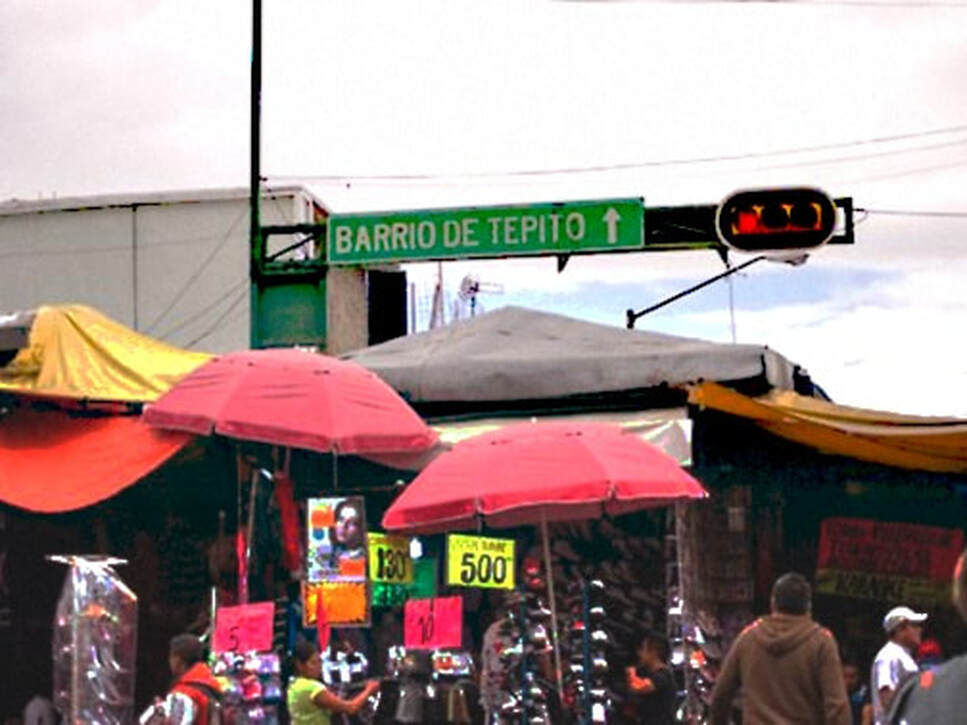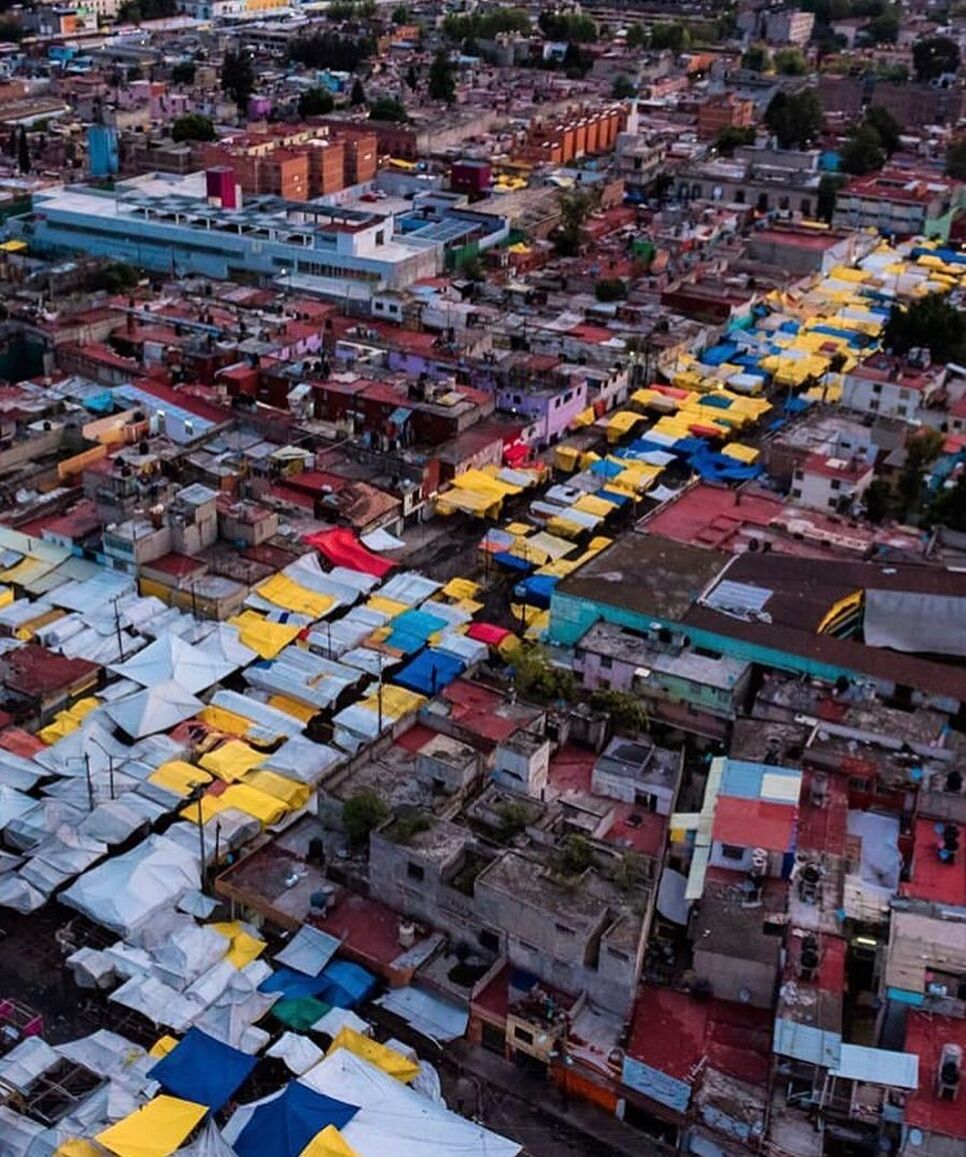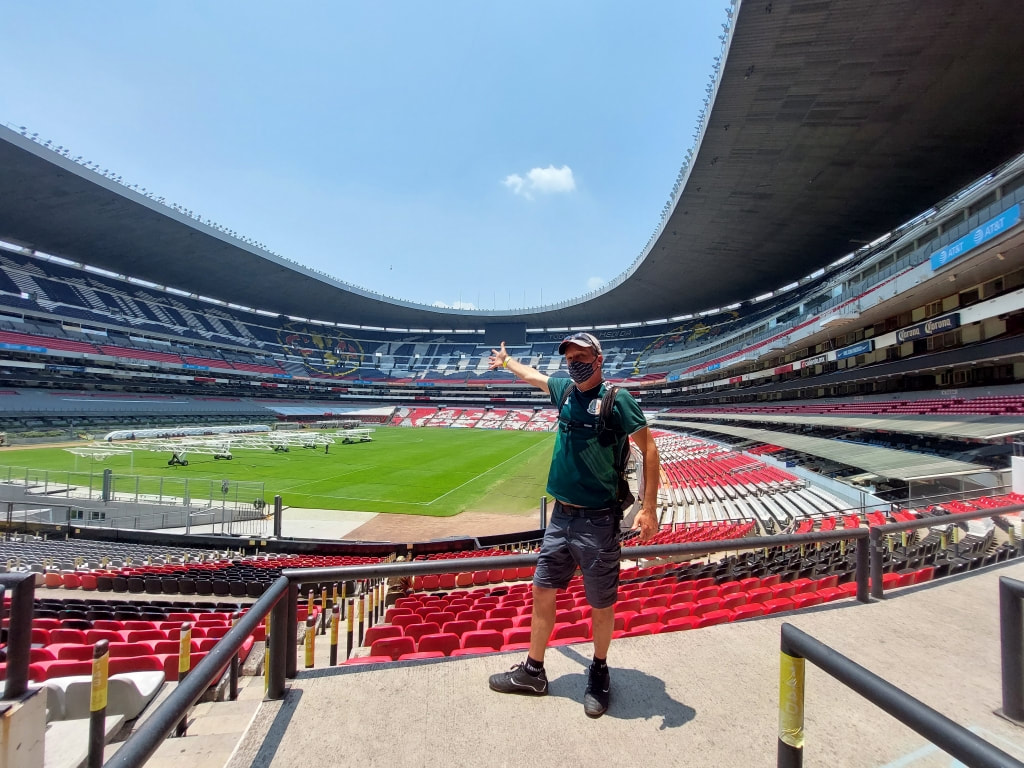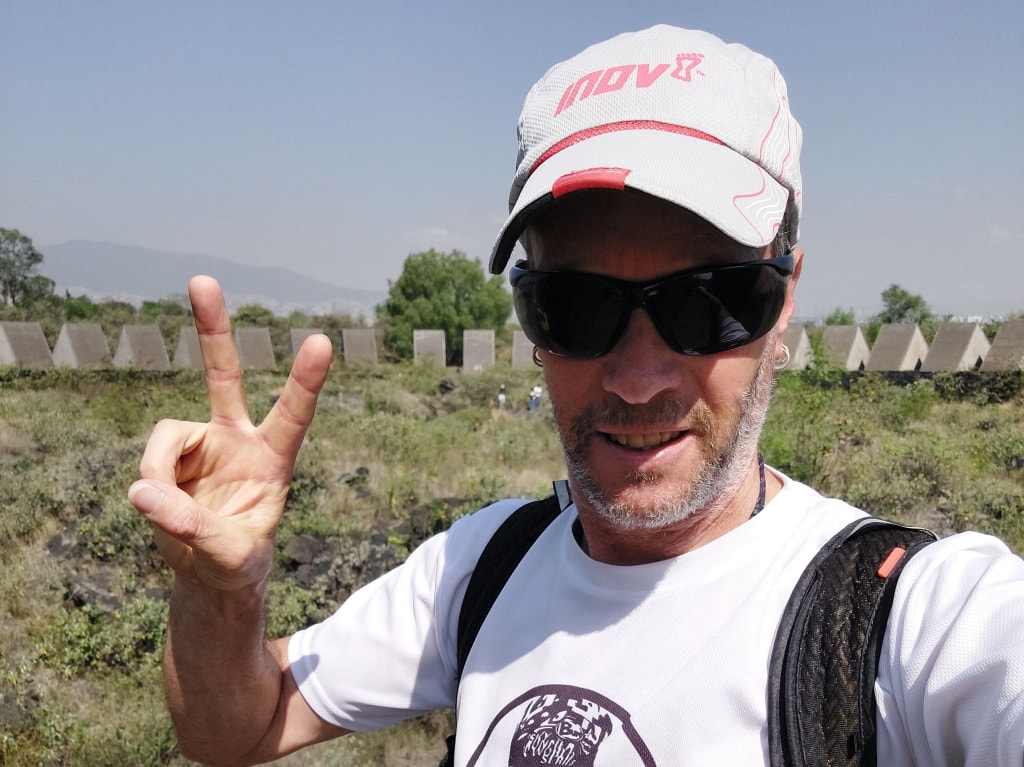Tepito: Just Exactly How Dangerous Is it?
February 24, 2021 | Tagged: Mexico | Property of Nomadic Backpacker
Tepito is said to be the most dangerous neighbourhood in Mexico City if not, the whole of Mexico.
But Just Exactly How Dangerous Is It? With Miss CDMX as my guide, I went to check it out
But Just Exactly How Dangerous Is It? With Miss CDMX as my guide, I went to check it out
So off we went to the Barrio Bravo on a regular Saturday during Covid-19, February 2021. We rode the Mexico City Metro Line 3 to Tepito.
We carried an ancient iPhone3, which I stuffed in the front pocket of my jeans, just in case there was an opportunity to take a couple of photos. There wasn't. The 2 images on this post are free stock photos
We had 1 small bag between us which Miss CDMX carried on her front with just a water bottle. We had a small amount of cash, less than 20 Pesos between us in our jeans' pockets, an almost empty metro card and a small bottle of sanitiser which I temptingly had in the back pocket of my jeans (more on this later).
Exiting the Tepito metro station, we plunged straight into the markets.
We carried an ancient iPhone3, which I stuffed in the front pocket of my jeans, just in case there was an opportunity to take a couple of photos. There wasn't. The 2 images on this post are free stock photos
We had 1 small bag between us which Miss CDMX carried on her front with just a water bottle. We had a small amount of cash, less than 20 Pesos between us in our jeans' pockets, an almost empty metro card and a small bottle of sanitiser which I temptingly had in the back pocket of my jeans (more on this later).
Exiting the Tepito metro station, we plunged straight into the markets.
Where and What is Tepito?
Tepito is a neighbourhood, a barrio, right in the heart of Mexico City, just a few blocks north of the Zocalo and the historic centre in Colonia Morelos.
And because of the goings on there, it is known as the most dangerous neighbourhood in the city but it's not just the market for which it has become famous. It has a long history of shoe-making and boxing too.
On the surface, it may just seem like a regular market. Counterfeit goods mostly. Theft and pickpocketing is common.
We were strolling. Suddenly there was a guy behind me, 'forced' to move in close as a car was passing, my pockets being frisked before he casually appeared to be making a simple purchase at a stall just in front of us.
They say that in Tepito, “todo se vende menos la dignidad”. "everything is sold except dignity" (Grisales 2003: 1).
It has long been known as a place that traded in stolen goods. And in the 1970s, the trade in counterfeit goods and illegally imported products known as fayuca began.
Sellers would cross the border to the US, buy or simply obtain, almost impossibly hard to get items and sell them in Tepito.
And since American items can now be easily obtained they switched to importing counterfeit products from China, much of which is stolen before the import duty has had a chance to pay thus costing the Mexican economy a lot of unpaid taxes. 70% of the counterfeit items in Mexico pass though Tepito.
It was also a place to buy pirated audio and video. This used to be produced in the neighbourhood itself in the "La Fortaleza", tenement blocks with hidden rooms and tunnels which were also falsely reported of having been pulled down.
In the 1985 Mexican earthquake, Tepito saw an influx of outsiders. It was no longer just a 'family' of Tepito born and bred residents.
The smuggling mafia knew that by giving stolen merchandise to the people of Tepito, they were going to be able to sell it because they already knew how to sell stolen items without the police interfering with them.
As we walked, we saw boxes and boxes of sports shoes being pushed through the streets on trollies known as diablos. We saw items set out on blankets. Just like any other street market.
And because of the goings on there, it is known as the most dangerous neighbourhood in the city but it's not just the market for which it has become famous. It has a long history of shoe-making and boxing too.
On the surface, it may just seem like a regular market. Counterfeit goods mostly. Theft and pickpocketing is common.
We were strolling. Suddenly there was a guy behind me, 'forced' to move in close as a car was passing, my pockets being frisked before he casually appeared to be making a simple purchase at a stall just in front of us.
They say that in Tepito, “todo se vende menos la dignidad”. "everything is sold except dignity" (Grisales 2003: 1).
It has long been known as a place that traded in stolen goods. And in the 1970s, the trade in counterfeit goods and illegally imported products known as fayuca began.
Sellers would cross the border to the US, buy or simply obtain, almost impossibly hard to get items and sell them in Tepito.
And since American items can now be easily obtained they switched to importing counterfeit products from China, much of which is stolen before the import duty has had a chance to pay thus costing the Mexican economy a lot of unpaid taxes. 70% of the counterfeit items in Mexico pass though Tepito.
It was also a place to buy pirated audio and video. This used to be produced in the neighbourhood itself in the "La Fortaleza", tenement blocks with hidden rooms and tunnels which were also falsely reported of having been pulled down.
In the 1985 Mexican earthquake, Tepito saw an influx of outsiders. It was no longer just a 'family' of Tepito born and bred residents.
The smuggling mafia knew that by giving stolen merchandise to the people of Tepito, they were going to be able to sell it because they already knew how to sell stolen items without the police interfering with them.
As we walked, we saw boxes and boxes of sports shoes being pushed through the streets on trollies known as diablos. We saw items set out on blankets. Just like any other street market.
Location of Tepito
The nearest metro stations are Lagunilla and Tepito which are both on Line B. But it's not that far from Bellas Artes or Allende or the Zocalo metro stations either.
Where does Tepito get it's name?
One theory is that the name Tepito comes from when the police started to use whistles and when they began their rounds, they would tell their colleagues, "Si veo a un ratero te pito" (If I see a thief, I'll whistle at you). Pito means whistle.
It was given the name Barrio Bravo or Fierce Neighbourhood. It is widely stated that this name was given due to its reputation as being dangerous. This is not true.
It has always been a place for the poor and a high degree of poverty and police have always liked to try and intimidate people who live in such environments but the locals were never afraid to fight back. Hence the name. Not for the barrio being dangerous per se.
It was given the name Barrio Bravo or Fierce Neighbourhood. It is widely stated that this name was given due to its reputation as being dangerous. This is not true.
It has always been a place for the poor and a high degree of poverty and police have always liked to try and intimidate people who live in such environments but the locals were never afraid to fight back. Hence the name. Not for the barrio being dangerous per se.
But is Tepito really that dangerous?
Tepito is famous for what you don't see in regular markets.
On every street corner, men, old and young on walkie-talkies.
Police do patrol the markets and their positions are constantly being relayed.
The trade of imported, counterfeit and stolen goods is just a front for what you don't see, for what is hidden out of sight.
I was a newbie at a place with such goings-on. My lover would squeeze my hand, once for 'something' on the left and twice for 'something on the right'. For me, it wasn't always easy to spot. Money being handed over. 'Fees' and 'protection money' being collected.
We'd hear the static of incoming messages on the walkie-talkies that the police were on the next corner and those selling items literally on the street would hurriedly pick up their stock on their blankets by cleverly placed loops at each corner and hustle out of sight.
Undercover cops have infiltrated the gangs. They know this and we were undoubtedly being watched. With my pale skin, I stick out like a sore thumb as someone who doesn't belong.
But we were just looking. We weren't talking with anyone, we didn't even buy a soda. We weren't shooting photos or videos.
Tepito is not a game.
We saw one seller being caught. His stock was confiscated. A 'present' will be paid and the seller will be back on the street within a few days.
It is also widely known that these busts are all staged.
He was 'caught' to allow those with more to play for, to escape and to allow it to be seen that the police were doing something proactive. He was caught as he was a long way down on the chain of hierarchy. If he had paid a few more pesos or a few more years under his belt he wouldn't have been the chosen one to have his stock confiscated, which is why they run.
But all this is just small fry.
The cartels control life inside Mexico. This is nothing new.
What is hidden inside Tepito, out of sight from regular people who come here to to buy a pair of knocked-off Converse, is the harder stuff. Guns, ammo, drugs and people trafficking. It would be impossible to just wander into an area anyways but they make sure just in case.
This is what makes Tepito dangerous. They don't want to goings on in the public-eye.
You'll do well to remember that people do 'disappear' here in Mexico, either being shot or kidnapped.
Sometimes, the arms and drugs that are trafficked through Tepito are allowed to be seen to have been confiscated and a large payment will be made to the government in return for the top names avoiding being charged and no one being shot.
On every street corner, men, old and young on walkie-talkies.
Police do patrol the markets and their positions are constantly being relayed.
The trade of imported, counterfeit and stolen goods is just a front for what you don't see, for what is hidden out of sight.
I was a newbie at a place with such goings-on. My lover would squeeze my hand, once for 'something' on the left and twice for 'something on the right'. For me, it wasn't always easy to spot. Money being handed over. 'Fees' and 'protection money' being collected.
We'd hear the static of incoming messages on the walkie-talkies that the police were on the next corner and those selling items literally on the street would hurriedly pick up their stock on their blankets by cleverly placed loops at each corner and hustle out of sight.
Undercover cops have infiltrated the gangs. They know this and we were undoubtedly being watched. With my pale skin, I stick out like a sore thumb as someone who doesn't belong.
But we were just looking. We weren't talking with anyone, we didn't even buy a soda. We weren't shooting photos or videos.
Tepito is not a game.
We saw one seller being caught. His stock was confiscated. A 'present' will be paid and the seller will be back on the street within a few days.
It is also widely known that these busts are all staged.
He was 'caught' to allow those with more to play for, to escape and to allow it to be seen that the police were doing something proactive. He was caught as he was a long way down on the chain of hierarchy. If he had paid a few more pesos or a few more years under his belt he wouldn't have been the chosen one to have his stock confiscated, which is why they run.
But all this is just small fry.
The cartels control life inside Mexico. This is nothing new.
What is hidden inside Tepito, out of sight from regular people who come here to to buy a pair of knocked-off Converse, is the harder stuff. Guns, ammo, drugs and people trafficking. It would be impossible to just wander into an area anyways but they make sure just in case.
This is what makes Tepito dangerous. They don't want to goings on in the public-eye.
You'll do well to remember that people do 'disappear' here in Mexico, either being shot or kidnapped.
Sometimes, the arms and drugs that are trafficked through Tepito are allowed to be seen to have been confiscated and a large payment will be made to the government in return for the top names avoiding being charged and no one being shot.
Is Tepito Safe for Tourists?
If you just come here to buy a pair of knocked-off Converse shoes or even buy a stolen phone, there are plenty of locals doing that, nothing ain't gonna happen to you.
Getting robbed is not exactly dangerous, they don't need to stab you to steal you phone. They are skilled professionals, not just a bunch of junkies.
Tepito is also famous for prostitution which in itself is not dangerous though such areas anywhere in the world at night are as sketchy AF and the types of people who hang around in such areas, if they think they could sell the shoes from beneath you they will. So don't go there at night and just stick to the main streets busy with locals just doing their shopping.
The danger comes when you start sticking your nose into to business that is basically, 'none of your business'. Tepito is not a joke.
They don't take kindly to vloggers coming in and start shooting film. Tepito is not a tourist destination, instagrammers, stay the fuck away. Chances are you will have your phone stolen anyways.
They are wary of people who don't belong. You will be watched, you will be followed.
So just go there, don't do anything stupid and later you can show off your fake Vans to your friends and boast how you survived the most dangerous barrio in Mexico City.
Getting robbed is not exactly dangerous, they don't need to stab you to steal you phone. They are skilled professionals, not just a bunch of junkies.
Tepito is also famous for prostitution which in itself is not dangerous though such areas anywhere in the world at night are as sketchy AF and the types of people who hang around in such areas, if they think they could sell the shoes from beneath you they will. So don't go there at night and just stick to the main streets busy with locals just doing their shopping.
The danger comes when you start sticking your nose into to business that is basically, 'none of your business'. Tepito is not a joke.
They don't take kindly to vloggers coming in and start shooting film. Tepito is not a tourist destination, instagrammers, stay the fuck away. Chances are you will have your phone stolen anyways.
They are wary of people who don't belong. You will be watched, you will be followed.
So just go there, don't do anything stupid and later you can show off your fake Vans to your friends and boast how you survived the most dangerous barrio in Mexico City.
Tips for Tepito (if you choose to visit):
Here are some tips if you chose to visit:
- Leave valuables behind (wallet, passport, keys, bank cards, cameras, even mobile phones)
- Visit with a local if you can
- Bring only a small amount of cash
- Keep items in front pockets
- Don't flash a camera around
- Stick to the market section of the barrio
- Leave way before dusk






